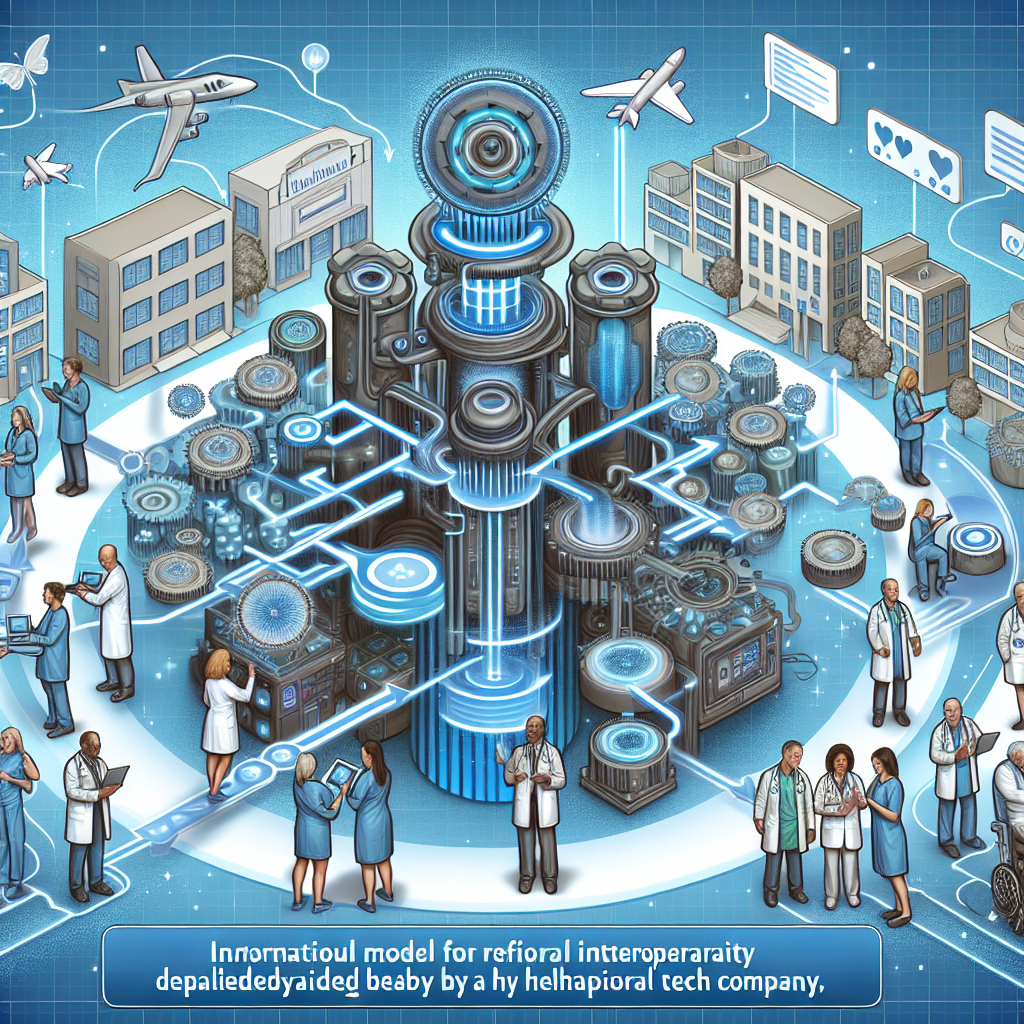Netsmart Unveils Innovative Referral Interoperability Model

In the rapidly evolving landscape of healthcare technology, interoperability has emerged as a critical component for enhancing patient care and streamlining operations. Netsmart, a leading provider of healthcare software solutions, has recently introduced an innovative referral interoperability model designed to address the challenges of fragmented healthcare systems. This article delves into the intricacies of Netsmart’s new model, exploring its potential impact on the healthcare industry, the technology behind it, and the benefits it offers to various stakeholders.
Understanding the Need for Interoperability in Healthcare
The healthcare industry is notorious for its complex and often siloed systems, which can hinder the seamless exchange of patient information. This lack of interoperability can lead to inefficiencies, increased costs, and compromised patient care. As healthcare providers strive to deliver more coordinated and patient-centered care, the demand for interoperable solutions has never been greater.
Interoperability in healthcare refers to the ability of different information systems, devices, and applications to access, exchange, and cooperatively use data in a coordinated manner. This capability is essential for ensuring that healthcare providers have access to comprehensive and up-to-date patient information, which is crucial for making informed clinical decisions.
Several factors have contributed to the growing need for interoperability in healthcare:
- Regulatory Requirements: Government regulations, such as the Health Information Technology for Economic and Clinical Health (HITECH) Act and the 21st Century Cures Act, have emphasized the importance of interoperability in healthcare.
- Value-Based Care Models: The shift towards value-based care models, which focus on patient outcomes rather than the volume of services provided, necessitates seamless data exchange to ensure coordinated care.
- Patient Expectations: Patients increasingly expect their healthcare providers to have access to their complete medical history, regardless of where they receive care.
Despite these drivers, achieving true interoperability in healthcare remains a significant challenge. Many healthcare organizations still rely on legacy systems that are not designed to communicate with one another, leading to data silos and fragmented care.
Netsmart’s Innovative Referral Interoperability Model
Netsmart’s new referral interoperability model aims to address these challenges by providing a comprehensive solution that facilitates the seamless exchange of patient information across different healthcare settings. This model leverages advanced technology and strategic partnerships to create a more connected and efficient healthcare ecosystem.
At the core of Netsmart’s model is its robust interoperability platform, which enables healthcare providers to share patient data securely and efficiently. This platform is designed to integrate with existing electronic health record (EHR) systems, allowing for the seamless exchange of information without the need for costly and time-consuming system overhauls.
Key features of Netsmart’s referral interoperability model include:
- Real-Time Data Exchange: The platform supports real-time data exchange, ensuring that healthcare providers have access to the most current patient information.
- Secure Data Sharing: Netsmart’s model prioritizes data security, employing advanced encryption and authentication protocols to protect patient information.
- Scalability: The platform is designed to scale with the needs of healthcare organizations, accommodating growth and changes in patient volume.
- Integration with Existing Systems: Netsmart’s model is compatible with a wide range of EHR systems, minimizing disruption to existing workflows.
By addressing the key barriers to interoperability, Netsmart’s referral interoperability model has the potential to transform the way healthcare providers share and access patient information, ultimately leading to improved patient outcomes and more efficient care delivery.
The Technology Behind Netsmart’s Model
Netsmart’s referral interoperability model is built on a foundation of cutting-edge technology that enables seamless data exchange and integration. This section explores the technological components that power Netsmart’s model and how they contribute to its effectiveness.
One of the key technologies underpinning Netsmart’s model is the use of application programming interfaces (APIs). APIs are essential for enabling different software systems to communicate with one another, facilitating the exchange of data between disparate systems. Netsmart’s platform leverages standardized APIs to ensure compatibility with a wide range of EHR systems and other healthcare applications.
In addition to APIs, Netsmart’s model incorporates cloud-based technology to enhance scalability and accessibility. By hosting its platform in the cloud, Netsmart can offer healthcare providers a flexible and scalable solution that can be accessed from anywhere with an internet connection. This cloud-based approach also allows for seamless updates and maintenance, ensuring that the platform remains up-to-date with the latest technological advancements.
Another critical component of Netsmart’s technology stack is its use of advanced data analytics. By harnessing the power of data analytics, Netsmart’s platform can provide healthcare providers with valuable insights into patient care and operational efficiency. These insights can be used to identify trends, optimize workflows, and improve patient outcomes.
Finally, Netsmart’s model prioritizes data security and privacy, employing advanced encryption and authentication protocols to protect patient information. This commitment to security is essential for maintaining patient trust and ensuring compliance with regulatory requirements.
Benefits of Netsmart’s Referral Interoperability Model
Netsmart’s referral interoperability model offers a wide range of benefits to healthcare providers, patients, and the healthcare industry as a whole. This section explores some of the key advantages of Netsmart’s model and how it can contribute to improved patient care and operational efficiency.
One of the primary benefits of Netsmart’s model is its ability to enhance care coordination. By facilitating the seamless exchange of patient information, healthcare providers can ensure that all members of a patient’s care team have access to the same comprehensive and up-to-date information. This improved coordination can lead to more informed clinical decisions, reduced duplication of tests and procedures, and ultimately better patient outcomes.
In addition to improving care coordination, Netsmart’s model can also help healthcare providers reduce costs. By streamlining data exchange and eliminating the need for manual data entry, healthcare organizations can reduce administrative burdens and improve operational efficiency. This increased efficiency can lead to cost savings, which can be reinvested in patient care and other critical areas.
For patients, Netsmart’s model offers the promise of more personalized and patient-centered care. With access to their complete medical history, healthcare providers can tailor treatment plans to meet the unique needs of each patient, leading to more effective and individualized care.
Finally, Netsmart’s model can contribute to improved population health management. By providing healthcare providers with access to comprehensive patient data, Netsmart’s platform can support efforts to identify and address population health trends, ultimately leading to better health outcomes for entire communities.
Case Studies and Real-World Applications
To illustrate the impact of Netsmart’s referral interoperability model, this section presents several case studies and real-world applications of the technology. These examples highlight how healthcare organizations have successfully implemented Netsmart’s model to improve patient care and operational efficiency.
One notable case study involves a large healthcare system that implemented Netsmart’s model to improve care coordination across its network of hospitals and clinics. By leveraging Netsmart’s platform, the healthcare system was able to streamline data exchange between its various facilities, leading to improved communication and collaboration among care teams. As a result, the healthcare system reported a significant reduction in duplicate tests and procedures, as well as improved patient outcomes.
Another example involves a community health center that used Netsmart’s model to enhance its population health management efforts. By gaining access to comprehensive patient data, the health center was able to identify trends and risk factors within its patient population, allowing it to implement targeted interventions and preventive measures. This proactive approach led to improved health outcomes for the community and reduced healthcare costs.
These case studies demonstrate the versatility and effectiveness of Netsmart’s referral interoperability model in a variety of healthcare settings. By facilitating seamless data exchange and improving care coordination, Netsmart’s model has the potential to transform the way healthcare is delivered and experienced.
Conclusion
Netsmart’s innovative referral interoperability model represents a significant advancement in the quest for seamless data exchange in healthcare. By addressing the key challenges of interoperability and leveraging cutting-edge technology, Netsmart’s model offers a comprehensive solution that can enhance care coordination, reduce costs, and improve patient outcomes.
As healthcare providers continue to navigate the complexities of an increasingly interconnected world, the importance of interoperability cannot be overstated. Netsmart’s model provides a promising path forward, offering a scalable and secure platform that can adapt to the evolving needs of the healthcare industry.
In conclusion, Netsmart’s referral interoperability model is poised to play a pivotal role in shaping the future of healthcare. By facilitating the seamless exchange of patient information and improving care coordination, Netsmart’s model has the potential to transform the way healthcare is delivered and experienced, ultimately leading to better health outcomes for patients and communities alike.





